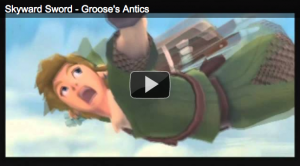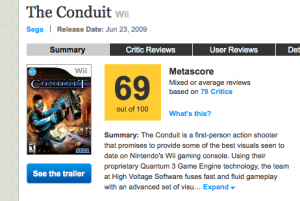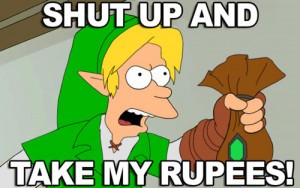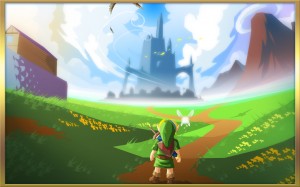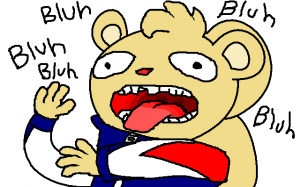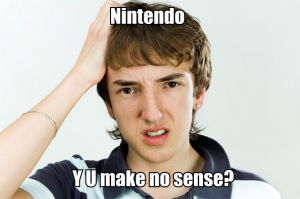Post of the Day: Skyward Sword ‘Groose’s Antics’ video
Posted on 13 years ago by Austin(@NE_Austin) in Features, Wii | 0 comments
I propose a caption contest for this image.
See how I did that thing where I named this post something as if it were part of a series that we’ve been doing for a while? That way I can trick people into thinking we have consistent enough features to have series of features and they’ll think we’re more professional. >:}
(You can view today’s “Post of the Day” here.)
Anyway, Skyward Sword comes out in six days, and I don’t think I’ve ever been this excited for a video game to come out before. The closest experience I can recall is the way I felt just before I went to pick up my Wii and Twilight Princess, and then after that the next most excited I’ve been was for The Conduit. We all know how that one worked out.
Clearly a masterpiece.
Now, for a while here I’d been following up on all of the videos, screenshots, and news posts about Skyward Sword. I felt bad for ruining some of the game’s mechanics, but I just couldn’t help myself. Eventually, spoilers went too far and I stopped myself from looking at anything relating to the game, save for a few of the spoiler-free reviews out there, when today I stumbled upon one of the best posts about the game I’ve seen in a long while. The reason for it is simply the thumbnail of Link falling and screaming or something, with a face tagged on that clearly says “IF I COULD TALK I WOULD BE SAYING ‘OH GOD’ RIGHT NOW”. It’s possibly the best picture of seen from the game, and just from that we can really see a couple of things:
First off, facial animations have gotten exponentially better since Twilight Princess. I know we sort of already knew this, but the amount of personality we see in such a goofy freeze-frame is wonderful, and I sincerely hope that this level of brilliance carries throughout the game. Secondly, anything with a character named “Groose” gets a 10/10 from me, especially if he’s always up to some silly antics. THIS GAME WILL BE THE BEST. Maybe. Does anyone here actually believe that Skyward Sword will truly be the best Zelda game? If it is, that means I’ll also consider it the best game of all time. That’s not something to be taken lightly at all…
25 years of Zelda: An in-depth look at the greatest video game franchise ever
Posted on 13 years ago by Austin(@NE_Austin) in Features, General Nintendo | 0 comments
As I sit down to write a feature that I’m sure will be simultaneously received as a decent piece of gaming “journalism” and a terrible rant perpetrated by none other than the king of Nintendo fanboys himself, I can’t help but feel as though much of what will be said in response to this is rather unimportant. Not to downplay the significance of feedback, because the vastness with which I appreciate it should never go unnoticed by all of you, but in light of the subject I’m going to be writing about from the true depths of my being, I ask if you all could forgo judgement and angry comments in lieu of positive discussion or civil disagreement.
That being said, I really think that someone bringing this subject to bear is long overdue, and while I’m certain I’m not the first to do it, I do hope that I can add a worthwhile two cents to the conversation, and get even more people talking. After all, video games are an art, and whether tradition-friendly die-hards want to agree with me or not, it is safe to say that the The Legend of Zelda stands high and mighty as the king of all this artistic benevolence.
The 8 Most Terrifying Game Characters (From Non-Horror Games) – That One Show
Posted on 13 years ago by Austin(@NE_Austin) in Features, General Nintendo | 0 comments
Oh man, it was quite a long road to get this totally edited and done, but it’s completed and uploaded and everything is good. Woofta.
Still a lot of technical things to be worked out with using all of the crazy new nonsense, but I’d say we did okay for a first episode!
~Austin
That One Show – Nintendo Is Better Than Sony and Microsoft No Matter What You Say
Posted on 13 years ago by Austin(@NE_Austin) in Features, General Nintendo, Videos | 0 comments
I figured the mid-afternoon/early evening are prime discussion hours, so I’m gonna sneak this into the news cycle now as opposed to later. Enjoy your pro-Nintendo nonsense, errybody. :]
That One Show – What the hell Nintendo what are you even doing I don’t get it seriously
Posted on 13 years ago by Austin(@NE_Austin) in Features, General Nintendo, Videos | 0 comments
This week I talk about how Nintendo doesn’t make any sense. Sound off in the comments. :]
The Nintendo 3DS Conference: Trailers, thoughts and Gatchaman
Posted on 13 years ago by Brian(@NE_Brian) in 3DS, Features | 0 comments
At Nintendo Everything, news tends to get buried under several pages extremely quickly, especially during one of the biggest game expos in the world. I thought it was for the best that I recapped all the Nintendo-related trailers and information given during the Nintendo 3DS Conference and offer up a few personal anecdotes. This year, Nintendo’s conference and TGS seemed to be focused on handhelds, with a heap of new games revealed for the 3DS as well as its biggest competitor, the PlayStation Vita. From the games showcased by both companies, we’ve got a general idea of where Nintendo are heading, or at least what their marketing strategies in Japan are. Anyway, here are five things we’ve learned from decoding moonspeak.
1. Nintendo totally stole Sony’s biggest titles
That One Show – Gaming backlogs, Leapfrogs, and General Dumb Stuff
Posted on 13 years ago by Austin(@NE_Austin) in 3DS, Features, General Nintendo, News, Videos, Wii | 0 comments
Been a while, guys! Still shakin’ the rust off… :b
Centipede: Infestation – Atari talks story, development, garden gnomes, and I ask about their next console
Posted on 13 years ago by Austin(@NE_Austin) in 3DS, Features, News, Wii | 0 comments
Side Note: The conference thing is tonight, so this may just get buried in the fray. I’ll just repost later, but I wanted to make sure it got up before Tuesday! Since I have more junk to post this week…
When most people hear the word “Reimagining”, they think of the failed attempts at bringing back franchises like Pac-Man, Frogger, Tomb Raider, and Sonic the Hedgehog over and over and over again, each time getting slightly excited at the prospect of having these games return to their glory days, and each time getting disappointed because, let be honest, they almost never do. Needless to say, when I went to play Atari’s upcoming Centipede: Infestation, I had pretty much made up my mind about the game and assumed I could’ve written my hands-on impressions in a split second with my eyes closed while I was asleep.
So when I got to the booth and my tour guide (weirdly also named “Austin”- I think Atari had been watching me sleep) brought me to the Wii version of Infestation, I put a smile on my face and braced myself for the worst. And of course, the one time I go to E3 and get to play a game like this, it actually isn’t all that shitty. Go figure.
Fast forward a few months and I find myself doing my first non-email interview with someone (this time over Skype!) with a wonderful guy over at Atari named Jonathan Moses, with whom I was set to talk all about this upcoming game. Of course, since I have the attention span of a rat, we ended up talking not only about Infestation, but about garden gnomes, development cycles, 3DS difficulties, and when we’d see Atari’s next home console. Though, we didn’t so much “talk” about a new console as “very briefly touch on it”, but I probably shouldn’t say more and just use that as a way to get people to read this unfairly.
Let’s Talk About The 3DS Circle Pad Attachment
Posted on 13 years ago by Austin(@NE_Austin) in 3DS, Features, General Nintendo | 0 comments
Not sure why, but I have an unusual amount of inspiration this evening! It’s a Wednesday night, I’m stressed out of my mind with work and school, yet I feel a weird urge to come on out here and write something so you all have something to think about when you begin your Thursdays across the globe! We’re halfway done with the week, so hang tight and a couple of days off will be at your doorstep in no time.
So last night we heard about two things, and if you’re a frequent visitor of the site, you most certainly are well acquainted with them by now: Monster Hunter Tri G, and the new 3DS Circle Pad attachment. In case you haven’t gotten all caught up, here’s the skinny on both of them:
3DS Circle Pad Attachment – Rundown/Your Thoughts?
Let’s Talk About Nintendo’s ‘Casual’ Side
Posted on 13 years ago by Austin(@NE_Austin) in Features, General Nintendo | 0 comments
For me, there are really only two types of games out there: Those that engage me mentally/emotionally, and those that make me happy or have fun. I don’t care what reviews say, how good gameplay is, whether the graphics are up to par, or whether I’m using an Xbox controller or a Corn Dog as my main method of input; if a game fits one of these two categories, then I’ll play it and I’ll love it.
For the most part, people don’t really hate on the games with srs business in them, such as Final Fantasy X, Flower, Zelda, etc. Sure, there are some haters out there, but generally speaking the basic idea is that such games are good quality and it makes sense that we enjoy them. The “fun” and “happy” games I refer to are ones such as Mario Sports Mix, Jeopardy, Mario Party, Wii Party, and Wii Sports. What a lot of people refer to as “party” games or “casual” games.
God forbid you try and say that these games are top-notch gaming.
